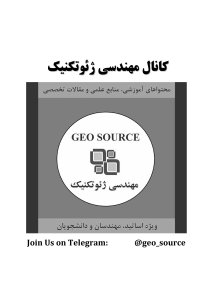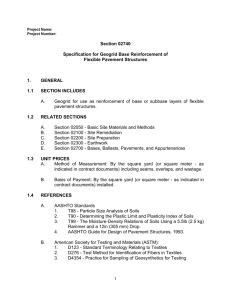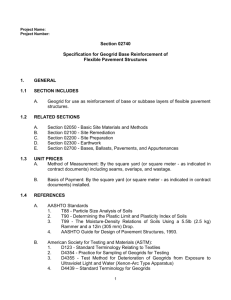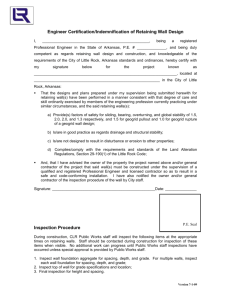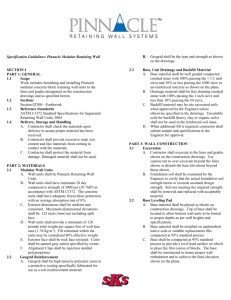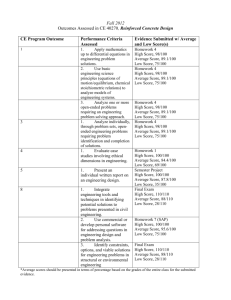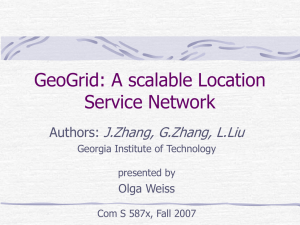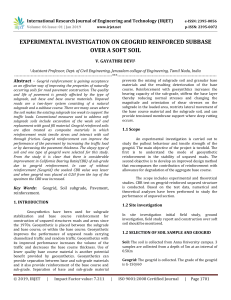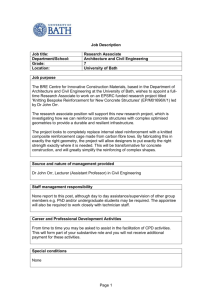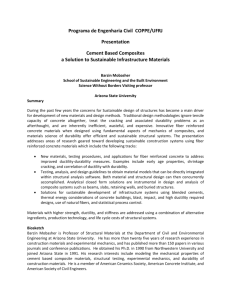Reinforced soil walls: Interstate 5/805 widening, San Diego
advertisement
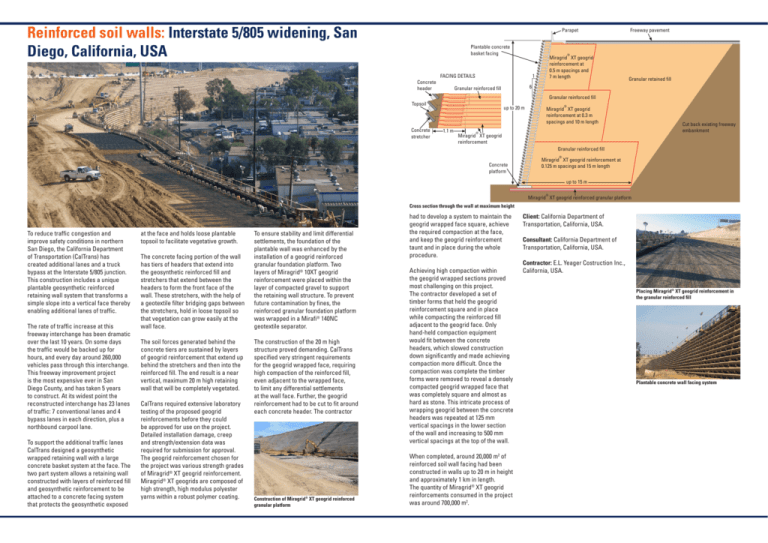
Reinforced soil walls: Interstate 5/805 widening, San Diego, California, USA Parapet Plantable concrete basket facing Concrete header Freeway pavement ® FACING DETAILS Miragrid XT geogrid reinforcement at 0.5 m spacings and 7 m length 1 Granular retained fill 6 Granular reinforced fill Granular reinforced fill Topsoil Concrete stretcher up to 20 m 1.1 m ® Miragrid XT geogrid reinforcement at 0.3 m spacings and 10 m length ® Miragrid XT geogrid reinforcement Cut back existing freeway embankment Granular reinforced fill ® Concrete platform Miragrid XT geogrid reinforcement at 0.125 m spacings and 15 m length up to 15 m ® Miragrid XT geogrid reinforced granular platform Cross section through the wall at maximum height To reduce traffic congestion and improve safety conditions in northern San Diego, the California Department of Transportation (CalTrans) has created additional lanes and a truck bypass at the Interstate 5/805 junction. This construction includes a unique plantable geosynthetic reinforced retaining wall system that transforms a simple slope into a vertical face thereby enabling additional lanes of traffic. The rate of traffic increase at this freeway interchange has been dramatic over the last 10 years. On some days the traffic would be backed up for hours, and every day around 260,000 vehicles pass through this interchange. This freeway improvement project is the most expensive ever in San Diego County, and has taken 5 years to construct. At its widest point the reconstructed interchange has 23 lanes of traffic: 7 conventional lanes and 4 bypass lanes in each direction, plus a northbound carpool lane. To support the additional traffic lanes CalTrans designed a geosynthetic wrapped retaining wall with a large concrete basket system at the face. The two part system allows a retaining wall constructed with layers of reinforced fill and geosynthetic reinforcement to be attached to a concrete facing system that protects the geosynthetic exposed at the face and holds loose plantable topsoil to facilitate vegetative growth. The concrete facing portion of the wall has tiers of headers that extend into the geosynthetic reinforced fill and stretchers that extend between the headers to form the front face of the wall. These stretchers, with the help of a geotextile filter bridging gaps between the stretchers, hold in loose topsoil so that vegetation can grow easily at the wall face. The soil forces generated behind the concrete tiers are sustained by layers of geogrid reinforcement that extend up behind the stretchers and then into the reinforced fill. The end result is a near vertical, maximum 20 m high retaining wall that will be completely vegetated. CalTrans required extensive laboratory testing of the proposed geogrid reinforcements before they could be approved for use on the project. Detailed installation damage, creep and strength/extension data was required for submission for approval. The geogrid reinforcement chosen for the project was various strength grades of Miragrid® XT geogrid reinforcement. Miragrid® XT geogrids are composed of high strength, high modulus polyester yarns within a robust polymer coating. To ensure stability and limit differential settlements, the foundation of the plantable wall was enhanced by the installation of a geogrid reinforced granular foundation platform. Two layers of Miragrid® 10XT geogrid reinforcement were placed within the layer of compacted gravel to support the retaining wall structure. To prevent future contamination by fines, the reinforced granular foundation platform was wrapped in a Mirafi® 140NC geotextile separator. The construction of the 20 m high structure proved demanding. CalTrans specified very stringent requirements for the geogrid wrapped face, requiring high compaction of the reinforced fill, even adjacent to the wrapped face, to limit any differential settlements at the wall face. Further, the geogrid reinforcement had to be cut to fit around each concrete header. The contractor Construction of Miragrid® XT geogrid reinforced granular platform had to develop a system to maintain the geogrid wrapped face square, achieve the required compaction at the face, and keep the geogrid reinforcement taunt and in place during the whole procedure. Achieving high compaction within the geogrid wrapped sections proved most challenging on this project. The contractor developed a set of timber forms that held the geogrid reinforcement square and in place while compacting the reinforced fill adjacent to the geogrid face. Only hand-held compaction equipment would fit between the concrete headers, which slowed construction down significantly and made achieving compaction more difficult. Once the compaction was complete the timber forms were removed to reveal a densely compacted geogrid wrapped face that was completely square and almost as hard as stone. This intricate process of wrapping geogrid between the concrete headers was repeated at 125 mm vertical spacings in the lower section of the wall and increasing to 500 mm vertical spacings at the top of the wall. When completed, around 20,000 m2 of reinforced soil wall facing had been constructed in walls up to 20 m in height and approximately 1 km in length. The quantity of Miragrid® XT geogrid reinforcements consumed in the project was around 700,000 m2. Client: California Department of Transportation, California, USA. Consultant: California Department of Transportation, California, USA. Contractor: E.L. Yeager Costruction Inc., California, USA. Placing Miragrid® XT geogrid reinforcement in the granular reinforced fill Plantable concrete wall facing system
